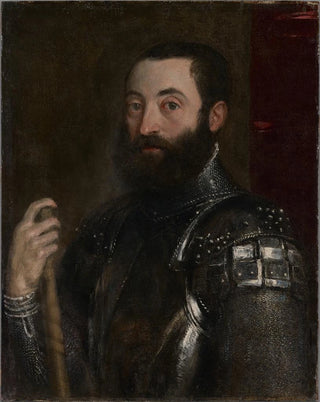Art print | Portrait of Guidobaldo II della Rovere, Duke of Urbino - Titian


View from behind

Frame (optional)
Art print Portrait of Guidobaldo II della Rovere, Duke of Urbino - Titian – Engaging Introduction
The "Portrait of Guidobaldo II della Rovere, Duke of Urbino" is an iconic work by the Venetian master Titian, created in the early 16th century. This painting, which embodies the very essence of the Renaissance, goes beyond simply depicting a nobleman; it also evokes the power and sophistication of an era where art and politics intertwined harmoniously. Guidobaldo II, a central figure at the Urbino court, is portrayed here with a nobility and dignity that transcend a mere portrait. Through this masterpiece, Titian invites us to delve into the complex world of the Italian court, where every detail matters and every gaze tells a story.
Style and uniqueness of the work
The work stands out for its masterful use of color and light, characteristic of Titian's style. The dark background highlights the figure, whose richly adorned clothing and expressive face immediately draw attention. The texture of the fabrics, rendered with remarkable precision, testifies to the artist's unparalleled craftsmanship. The play of light, which caresses the duke's face, creates an atmosphere that is both intimate and solemn. Titian manages to breathe palpable life into his subject, making him almost accessible, while maintaining an aura of majesty. This portrait is not limited to a simple physical representation; it is a true psychological exploration, where the duke's gaze seems to question the viewer, engaging in a silent yet profound dialogue.
The artist and his influence
Titian, born Tiziano Vecellio, is considered one of the greatest masters of Venetian painting. His career, spanning over six decades, was marked by an impressive stylistic evolution, oscillating between realism and idealization. He captured the spirit of his time, influencing not only his contemporaries but also generations of artists to come. His innovative approach to color and composition paved the way for new pictorial techniques, making him a pioneer of Baroque painting. The "Portrait of Guidobaldo"

Matte finish

View from behind

Frame (optional)
Art print Portrait of Guidobaldo II della Rovere, Duke of Urbino - Titian – Engaging Introduction
The "Portrait of Guidobaldo II della Rovere, Duke of Urbino" is an iconic work by the Venetian master Titian, created in the early 16th century. This painting, which embodies the very essence of the Renaissance, goes beyond simply depicting a nobleman; it also evokes the power and sophistication of an era where art and politics intertwined harmoniously. Guidobaldo II, a central figure at the Urbino court, is portrayed here with a nobility and dignity that transcend a mere portrait. Through this masterpiece, Titian invites us to delve into the complex world of the Italian court, where every detail matters and every gaze tells a story.
Style and uniqueness of the work
The work stands out for its masterful use of color and light, characteristic of Titian's style. The dark background highlights the figure, whose richly adorned clothing and expressive face immediately draw attention. The texture of the fabrics, rendered with remarkable precision, testifies to the artist's unparalleled craftsmanship. The play of light, which caresses the duke's face, creates an atmosphere that is both intimate and solemn. Titian manages to breathe palpable life into his subject, making him almost accessible, while maintaining an aura of majesty. This portrait is not limited to a simple physical representation; it is a true psychological exploration, where the duke's gaze seems to question the viewer, engaging in a silent yet profound dialogue.
The artist and his influence
Titian, born Tiziano Vecellio, is considered one of the greatest masters of Venetian painting. His career, spanning over six decades, was marked by an impressive stylistic evolution, oscillating between realism and idealization. He captured the spirit of his time, influencing not only his contemporaries but also generations of artists to come. His innovative approach to color and composition paved the way for new pictorial techniques, making him a pioneer of Baroque painting. The "Portrait of Guidobaldo"






